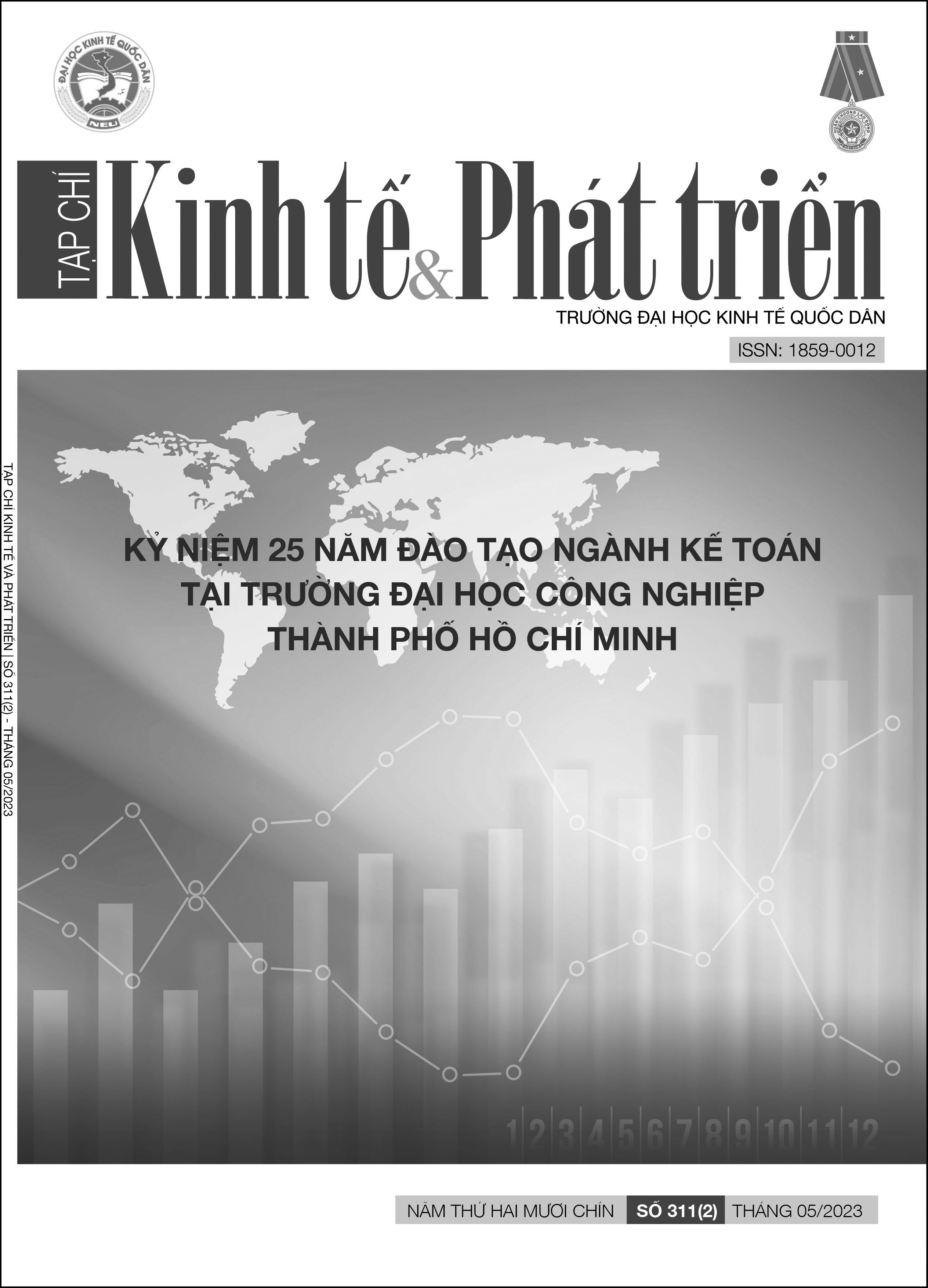Đầu tư trực tiếp nước ngoài, phát triển thị trường chứng khoán và tăng trưởng kinh tế - Nghiên cứu trường hợp khu vực Đông Nam Á và Đông Á
DOI:
https://doi.org/10.33301/JED.VI.877Từ khóa:
Tăng trưởng, chứng khoán, nước ngoài, đầu tưTóm tắt
Thị trường chứng khoán là kênh huy động vốn dài hạn cho nền kinh tế. Qua thị trường chứng khoán, các quốc gia huy đông nguồn vốn nhàn rỗi cho nền kinh tế để thực hiện các dự án đầu tư và phát triển và cuối cùng tạo tăng trưởng kinh tế. Mục tiêu của nghiên cứu nhằm đánh giá tác động của thị trường chứng khoán lên tăng trưởng kinh tế tại quốc gia và vùng lãnh thổ ở Đông Nam Á và Đông Á trong khoảng thời gian 2010 đến 2019, đặc biệt đặt trong mối quan hệ tương tác với khả năng thu hút nguồn vốn đầu tư trực tiếp nước ngoài, kết quả nghiên cứu khẳng định rằng: thị trường chứng khoán và thu hút vốn đầu tư trực tiếp nước ngoài có tác động tích cực lên tăng trưởng kinh tế. Hơn nữa, hiệu quả của thu hút vốn đầu tư trực tiếp nước ngoài lên tăng trưởng kinh tế sẽ tăng lên tại quốc gia có thị trường chứng khoán phát triển. Nghiên cứu cũng khẳng định tác động tích cực của chất lượng nguồn nhân lực và tăng trưởng kinh tế.
Tài liệu tham khảo
Aigheyisi, O.S. (2016), ‘Does Stock Market Development Play Any Role In The Effect Of Fdi On Economic Growth In Nigeria? An Empirical Investigation’, Oradea Journal of Business and Economics, 1(2), 51-61.
Afonso, A. & Reimers, M. (2022), ‘Does the introduction of stock exchange markets boost economic growth in African countries?’, Journal of Comparative Economics, 50(2), 627–640. DOI: https://doi.org/https://doi.org/10.1016/j.jce.2022.01.006.
Baier, S.L., Dwyer, G.P. & Tamura, R. (2004), ‘Does opening a stock exchange increase economic growth?’, Journal of International Money and Finance, 23(3), 311–331. DOI: https://doi.org/https://doi.org/10.1016/j.jimonfin.2004.01.001.
Boeing, P., Eberle, J. & Howell, A. (2022), ‘The impact of China’s R&D subsidies on R&D investment, technological upgrading and economic growth’, Technological Forecasting and Social Change, 174, 121212. DOI: https://doi.org/https://doi.org/10.1016/j.techfore.2021.121212.
Carp, L. (2012), ‘Can Stock Market Development Boost Economic Growth? Empirical Evidence from Emerging Markets in Central and Eastern Europe’, Procedia Economics and Finance, 3, 438–444. https://doi.org/https://doi.org/10.1016/S2212-5671(12)00177-3.
Drabek, Z. (2021), ‘Governance of FDI and the East Asian Economic Community’, Asia and the Global Economy, 1(1), 100001. DOI: https://doi.org/https://doi.org/10.1016/j.aglobe.2021.100001.
Diaconu (Maxim), L. (2014), ‘The Foreign Direct Investments in South-East Asia during the Last Two Decades’, Procedia Economics and Finance, 15, 903–908. DOI: https://doi.org/https://doi.org/10.1016/S2212-5671(14)00554-1.
Fan, H., He, S., & Kwan, Y. K. (2019), ‘Foreign direct investment and productivity spillovers: is China different?’, Applied Economics Letters, 26(20), 1675–1682. DOI: https://doi.org/10.1080/13504851.2019.1591591.
Fuchs-Schündeln, N. & Funke, N. (2001), ‘Stock market liberalizations: Financial and macroeconomic implications’, IMF Working Papers No. 2001(193).
Guo, H., Hu, J., Yu, S., Sun, H. & Chen, Y. (2012), ‘Computing of the contribution rate of scientific and technological progress to economic growth in Chinese regions’, Expert Systems with Applications, 39(10), 8514–8521. DOI: https://doi.org/https://doi.org/10.1016/j.eswa.2011.12.032.
Gutiérrez-Portilla, P., Maza, A., & Villaverde, J. (2019), ‘A spatial approach to the FDI-growth nexus in Spain: Dealing with the headquarters effect’, International Business Review, 28(6), 101597. DOI: https://doi.org/https://doi.org/10.1016/j.ibusrev.2019.101597.
Kapaya, S.M. (2020), ‘Stock market development and economic growth in Tanzania: an ARDL and bound testing approach’, Review of Economics and Political Science, 5(3), 187-206. DOI: https://doi.org/10.1108/REPS-11-2019-0150.
Levine, R. & Zervos, S. (1998), ‘Stock Markets, Banks, and Economic Growth’, The American Economic Review, 88(3), 537–558.
Magazzino, C. & Mele, M. (2022), ‘Can a change in FDI accelerate GDP growth? Time-series and ANNs evidence on Malta’, The Journal of Economic Asymmetries, 25, e00243. DOI: https://doi.org/https://doi.org/10.1016/j.jeca.2022.e00243.
Nguyễn Thị Phương Nhung (2016), ‘Mối quan hệ giữa tăng trưởng và thị trường chứng khoán tại Việt Nam,’ Luận án Tiến sĩ, Trường Đại học Kinh tế Luật – Đại học Quốc gia Thành phố Hồ Chí Minh.
Ortiz, E., Cabello, A., & de Jesús, R. (2007), ‘The Role of Mexico’s Stock Exchange In Economic Growth’, The Journal of Economic Asymmetries, 4(2), 1–26. DOI: https://doi.org/https://doi.org/10.1016/j.jeca.2007.02.001.
Park, C.-Y. Shin, K., & Kikkawa, A. (2022), ‘Demographic change, technological advance, and growth: A cross-country analysis’, Economic Modelling, 108, 105742. DOI: https://doi.org/https://doi.org/10.1016/j.econmod.2021.105742.
Qamri, G. M., Sheng, B., Adeel-Farooq, R. M., & Alam, G. M. (2022), ‘The criticality of FDI in Environmental Degradation through financial development and economic growth: Implications for promoting the green sector’, Resources Policy, 78, 102765. DOI: https://doi.org/https://doi.org/10.1016/j.resourpol.2022.102765.
Rajapakse, R.P.C.R. (2018), ‘The Relationship Between the Stock Market and Foreign Direct Investment (FDI) in Sri Lanka-Evidence from VAR and Co-Integration Analysis’, Global Journal of Management and Business Research: B Economics and Commerce, 18(5), Available at SSRN: https://ssrn.com/abstract=3231665.
Sultana, T., Dey, S.R. & Tareque, M. (2022), ‘Exploring the linkage between human capital and economic growth: A look at 141 developing and developed countries’, Economic Systems, 101017. DOI: https://doi.org/https://doi.org/10.1016/j.ecosys.2022.101017.
Yang, Y., Qamruzzaman, M., Rehman, M.Z. & Karim, S. (2021), ‘Do Tourism and Institutional Quality Asymmetrically Effects on FDI Sustainability in BIMSTEC Countries: An Application of ARDL, CS-ARDL, NARDL, and Asymmetric Causality Test’, Sustainability, 13(17). DOI: http://dx.doi.org/10.3390/su13179989.
Zaman, M., Pinglu, C., Hussain, S. I., Ullah, A., & Qian, N. (2021), ‘Does regional integration matter for sustainable economic growth? Fostering the role of FDI, trade openness, IT exports, and capital formation in BRI countries’, Heliyon, 7(12), e08559. DOI: https://doi.org/https://doi.org/10.1016/j.heliyon.2021.e08559.
UNCTAD (2021), Foreign direct investment, last retrieved on August 1st, 2022, from <https://hbs.unctad.org/foreign-direct-investment/>.
UNCTAD (2022), Foreign investment in developing Asia hit a record $619 billion in 2021, last retrieved on October 28th, 2022, from <https://unctad.org/news/foreign-investment-developing-asia-hit-record-619-billion-2021>.
Wang, R. & Tan, J. (2021), ‘Exploring the coupling and forecasting of financial development, technological innovation, and economic growth’, Technological Forecasting and Social Change, 163, 120466. DOI: https://doi.org/https://doi.org/10.1016/j.techfore.2020.120466.





